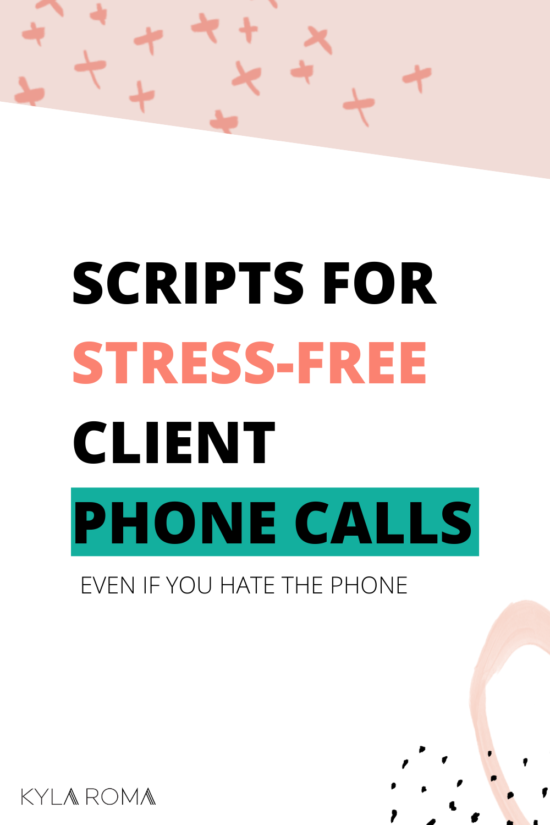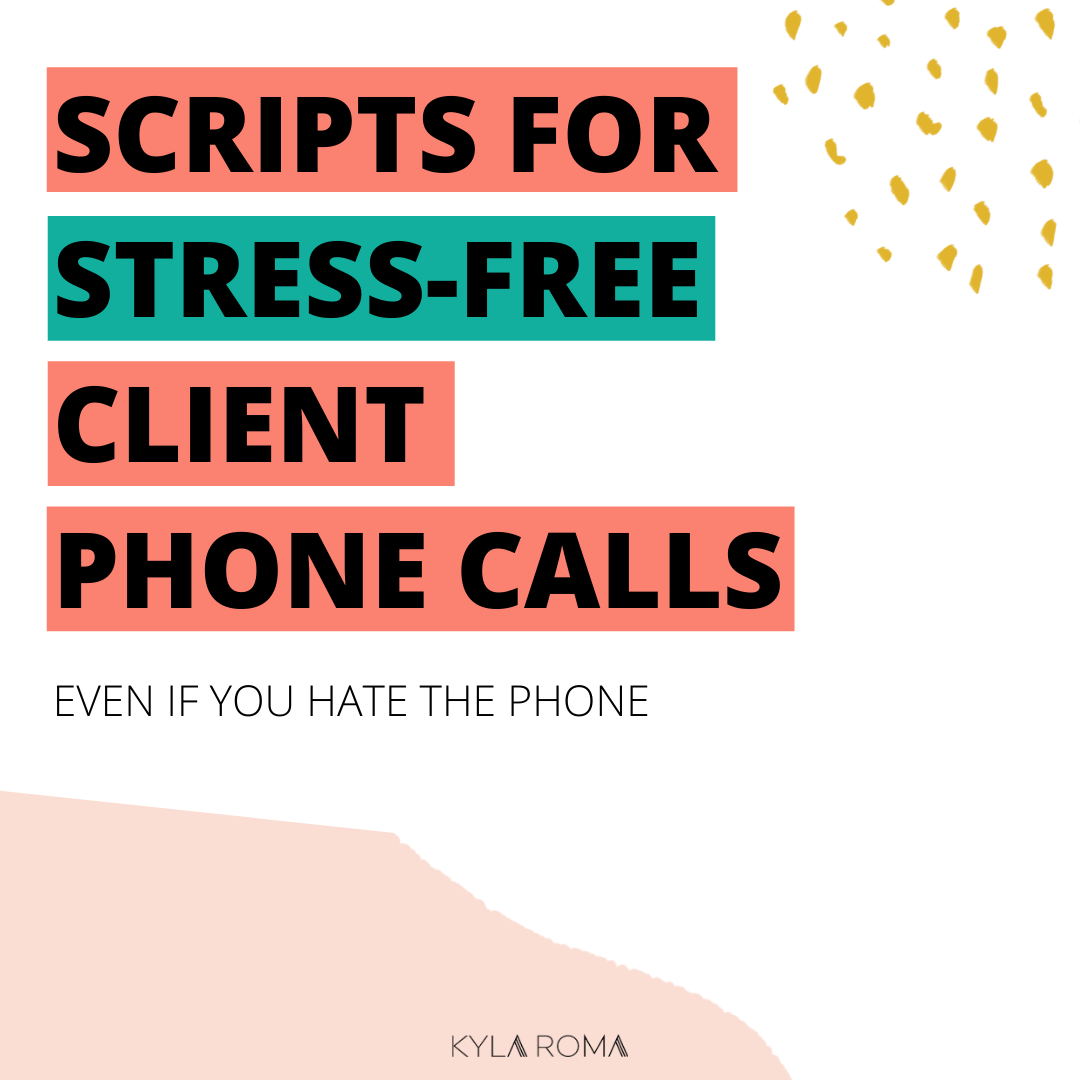Productivity for Entrepreneurs
May 29th, 2020
Scripts to make customer phone calls simple and stress-free
When you’re a small business owner or freelancer and your clients start asking if you can stop emailing and have a phone meeting… well, leading customer phone calls can seem really stressful! For service based business owners and freelancers, leading a customer phone call can be a crucial way to drive a project forward, get feedback on a design or find out what your customer wants more or less of.
You want to be professional, you want to keep the conversation flowing and you want to hang up without feeling like someone put you on spot, or forced you into making a commitment that’s going to wreck your work schedule.
All while a tiny voice in your head shouts “DON’T MESS UP! DON’T MESS UP! DON’T MESS UP! — AH!! YOU MESSED UP!!!” (Unless that’s just me?)
I’m an introvert, so jumping on the phone isn’t my first instinct either. But after doing hundreds of free discovery calls with potential clients and working with clients by phone when I was web designer, they became one of my favourite parts of my job. This post will take you through exactly how you can get through your calls as the confident, masterful version of yourself with less effort and stress.

There are lots of service based business owners, entrepreneurs, and creatives who work with an emphasis on written communication.
It’s how I ran my first business as a web designer and there’s good reason behind it: You have a written record of decisions (yah!), and you can break an email into a to-do list. (double yah!)
But the good reasons to communicate with clients by email are no reason to stress over client phone calls! (Click to tweet it)
Freelancers & service based business owners need to talk about are the problems that working exclusively by email can cause.
Because, really, it’s only normal to exclusively communicate in writing if you’re writing to your paramour who has a handsome income of $4000 per year and, because it’s the year 1810, you really need to lock that down. And even then, unless you’re royalty, it would raise some eyebrows. (As always: if you’re 1800’s royalty, please email me. I have tips.)
Since I’m guessing that isn’t the case, you are the only only person your client is communicating with this way, which means…
- The problem: Writing may not be your client’s natural strength, so it’s fairly time-consuming for them.
- Causes the headache: The feedback you get is slow, incomplete, cryptic or late.
- The problem: Your client doesn’t have the jargon or technical understanding that you do, so they can’t express themselves fully. Your customer won’t write out questions or concerns that are vague, awkward or rely on several clarifications first, like they would in casual conversation.
- Causes the headache: Sure, you work with the feedback you get, but you build in a much higher chance of your client not loving the end result because they were never able to give deep feedback to you in the first place. This means fewer testimonials, cancelled contracts and a reputation that doesn’t help grow your business.
- The problem: There may be enough social signals in their writing for you to interpret what your client says, but not enough for you to know what they really mean, and actually feel. Even if you’re an anxious introvert (and believe me, I’ve been there!) you’re a highly tuned person interpretation machine… without the information you need to use those skills.
- Causes the headache: You can’t put your social skills to work, use your intuition to ask the right questions or detect a question or concern your customer is hesitant to ask. By stripping out a layer of communication, you increase the chance of miscommunication and have to work hard to catch problems early on.
Sound familiar? Your business could be sending you a sign to reevaluate how you communicate with your clients!
After spending 7+ years doing project management and building two service based businesses, creating positive, safe spaces for live discussion is still one of my favourite things, so I wanted to share a basic framework for handling client conversations that I’ve used since 2009. I hope that having it with you for your next call makes your time on the phone less stressful, and make your business more productive!
Just remember: Like anything else, how you communicate is a muscle. The more you use it, the stronger you’ll get, and it only gets easier.
Scripts to make phone meetings and customer phone calls simple and stress-free:
Sometimes it’s hard to know where to start, so these scripts can be used as little prompts to help you feel more confident about setting the tone and moving the conversation along.
1. Welcome, with a focus on what’s at hand:
- It’s great to speak with you! How have you been doing, and how has this project been treating you?
- Thanks for making time to speak to me today. How have things been progressing on your end since we last spoke?
- It’s great to hear from you – and I need to know, what has this project stirred up since we last spoke?
- It’s good to speak with you. How have the last few weeks on the project been going?
- Thanks for the meeting – I need you to catch me up! What are the highlights and challenges since since we last connected?
2. Set the conversation scope and open the door for feedback without steering the conversation:
- I’ve been looking forward to hearing your thoughts today. Would you like to start with _(aspect of the project)_, and then move to _(other aspect of the project)_?
- Today I thought that we could cover _(aspect of the project)_ and _(other aspect of the project)_. Does that sound good, and is there anything else that you’d like to make sure we touch on?
- We’ve been focusing on _(aspect of the project)_ recently, so I thought we can build on that by talking about _(other aspect of the project)_. From your perspective, would that be the most productive use of our time? Is there anything else we need to cover?
- In your email it sounded like you’ve been focused on _(aspect of the project)_, so I thought we could touch on that before we dive into _(aspect of the project)_. Does that work for you?
- Since we’ve been working on _(aspect of the project)_ lately, would you like to review that before we head into _(aspect of the project)_?
- I think a natural starting point could be _(aspect of the project)_ , and then _(aspect of the project)_. What would do you want to make sure we get through today?
Then bring up the points you want to share, and guide the conversation:
3. Request more information and clarity
- Oh, that’s interesting! Can you tell me more about that?
- I want to make sure I understand the full picture of what you’re getting at on this point. Can you share more?
- I see what you mean. Does anything else come to mind?
- Okay, you mean that _(recap of what was said)_. Does that sound right?
- Let’s back up for a moment, how does this effect the big picture?
- Alright, I think I’m getting the picture. So, what else would be impacted by this?
4a. Agree…
- Agreed.
- Sure
- I can do that.
- That makes sense.
- Yes, absolutely!
- Yes, let’s get this on the calendar.
- I think that is a great idea.
4b. …or disagree without throwing anyone under the bus:
- I can see what you mean, but I think there’s another way to get at this. I’d consider…
- Something about this doesn’t feel completely right. I think we can serve the project even better if I/we re-work this a little. What about if…
- I appreciate the thought behind this, but I’m not sure it’s the strongest way forward. I’d want to focus on…
- Alright, I’ve been taking some notes as we speak, and I’d like to pause on this point for now so I/we can regroup and look at the next steps. For now, let’s…
- I can see where you are going with this, but I’m not convinced that it’s going to make a substantial impact. Here’s why:
- That’s close, but I don’t think we’re quite hitting the nail on the head. What if…
4c. …or ask for time to gather your thoughts and schedule the next steps:
- Sure. Let me look into that and see if there’s anything else we need to consider. I’ll follow up on email.
- This sounds great. Let me double check that there isn’t anything else we need to consider, and I’ll send you an email confirming who’s doing what, when.
- What I want to say is: 100 times yes! Absolutely! Unfortunately, project scheduling requires a little more subtly. Let me check to make sure everything else lines up, and circle back with timelines for our next steps.
- That’s great. For now, let’s pause here so I can check my calendar and make sure that everything’s accounted for.
- I love your enthusiasm! Let me take a look at this and the project timeline to make sure everything looks kosher.
4d. …or clarify again
(See step 3)
5a. Stay focused & stay on time:
- This is interesting, but is it essential to what we’re trying to accomplish today?
- Let’s circle back to the main point for a moment.
- Let’s make sure we’re putting our time where we need to move forward next.
- This is such a big topic, and I really want to respect your time. Let’s come back to…
- I understand the concern, but let’s focus on working through _(the point of the meeting)_ fully before we move on.
- I want to give this the time it needs, without pulling us away from our goals for today. Would a dedicated meeting be helpful, or could you pull together a list of questions that could be a jumping off point?
- Let’s tap the breaks on this before we get carried away. Why don’t we set aside ten mins at the end of the meeting to circle back to this, if it still feels important?
6. Move toward action:
- Is there one big action or goal that we can add to this list that would automatically accomplish several of these smaller goals?
- Is there anything on the table that we could remove without having a negative consequence?
- Could we test a minimalist version of the full idea to get started?
- Let’s pause and regroup in five minutes. When we come back we’ll start by looking for the good ideas that aren’t crucial at this moment, so we can focus on what’s essential.
- Alright, let’s shift gears. What questions need to be answered for the next two weeks to run smoothly?
7. Agree on the next steps:
- This is what I’m going to do next: _______. What’s on your to-do list from this meeting?
- Let’s recap: I’m going to _(action)_ by _(date)_ and you will _(action)_ by _(date)_. Does that sound right?
- How can I send you my portion of this? / How will you send me your portion of this?
- When should you/I commit to having this completed by?
8. End strong & set expectations:
- I think that covers it – thanks for the great call! Do you have any questions I can answer before we wrap up today?
- Thanks for the meeting, it was great to connect and move this forward! I’ll be in touch early next week at the latest.
- Thanks again for the call, please don’t hesitate to drop me a quick email or call if any questions come up in the coming days.
- Thank you again, I appreciate your time, and you’ll hear from me in the coming days.
I hope these scripts help you start leading client meetings, project meetings, and customer phone calls with more confidence so you can relax and develop your style.
Do you look forward to customer phone calls? Do they stress you out?
What’s the most challenging part of phone conversations with clients for you, or what used to be?




Omg…I know this is older content, but it was exactly what I needed and was looking for…sometimes I find myself delaying my call backs because I am just not confident on the conversation delivery and can sometimes stammer through them. Yet, I considered a script would help and your content saves the day!!
Ah, I love hearing that Sharonda! These were huge helps to me, and I’m glad that they’re making life easier for you :)
This was wildly helpful. Such a smart idea for a post.
Thanks for commenting, Rachel. I’m glad it was helpful!
I love this- I usually map out my calls ahead of time to make sure I know what I need to cover, and this is a great addition.
I’m glad to hear this is helpful, Abby! Thanks for letting me know :)